UK troops have test-fired the Sky Sabre air defence system on British soil for the first time, according to a British Army news update.
The live firing took place during Exercise Formidable Shield 25 in the Outer Hebrides, marking what the Army described as a significant step in strengthening NATO’s defensive shield.
Sky Sabre is designed to counter modern airborne threats, including aircraft, drones and precision-guided munitions. Using the Common Anti-Air Modular Missile (CAMM), the system can track multiple targets simultaneously at ranges of up to 120km. It is noted for its extreme accuracy, with the ability to hit an object the size of a tennis ball travelling at twice the speed of sound.
The system integrates three components: the Agile Multi-Beam “Giraffe” radar, a battle management and communications centre, and Land Ceptor missile launch vehicles. During the Hebrides exercise, Sky Sabre was employed alongside NATO allies’ air and naval forces, including Norwegian F-35s and UK Eurofighters, in complex scenarios involving both ballistic missile defence and air defence operations.
Warrant Officer Class 2 Ben Norris of 16th Regiment Royal Artillery, the unit operating the system, said: “What we can take away from this is how complex our system is and how unique it is against all the other equipment sets within NATO. We bring such a unique variation of Air Defence within that concept.”
The Ministry of Defence used the exercise to highlight wider investment in UK ground-based air defence. On the same day, ministers confirmed the doubling of deployable Sky Sabre units, with a new £118 million contract for six additional Land Ceptor launchers to be built by MBDA in Bolton, supporting up to 140 jobs.
Officials described the combined exercise and procurement as part of the government’s “NATO First” approach under the Strategic Defence Review. By expanding Sky Sabre, the Army aims to reinforce homeland defence and boost contributions to collective deterrence, while sustaining industrial capacity in the North West.
Formidable Shield is NATO’s largest live-fire naval exercise, involving nine allies and multiple aircraft, ships and ground units. For the British Army, the debut of Sky Sabre in a UK setting provided a public demonstration of its evolving role in a layered defence network designed to counter a wide range of aerial threats.


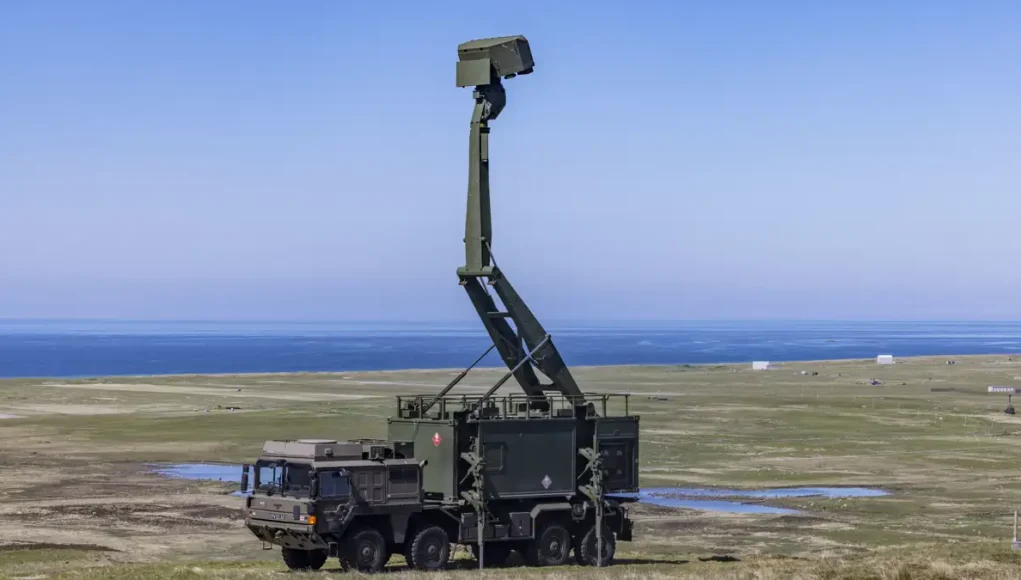



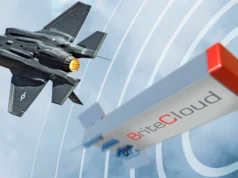

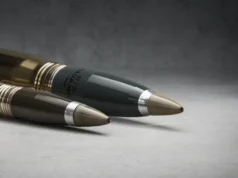
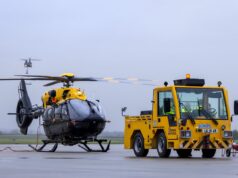

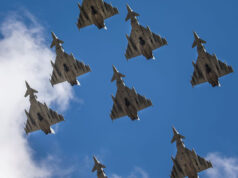
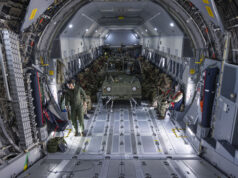

“The Ministry of Defence used the exercise to highlight wider investment in UK ground-based air defence. On the same day, ministers confirmed the doubling of deployable Sky Sabre units.”
A great day for the HMG PR team.
We could treble our SP howitzer numbers and still only end up with 42…
Ah but yea but no but the real threat is from Tennis balls travelling at twice the speed of sound.
We are currently “Under Armed”.
Even John MacEnroe used to say “You cannot be serious” when faced with his opponents balls.
The threat is real.
Oh and, is it me or is that Umpires chair a bit high ?
# Duce
Doubling or trebling the observation point presumably multiplies the “beyond horizon” vision by those factors?
To be fair, I’m sure they went as small as golf balls when “bigging Up/Bugging out” the Type 45s?
Wasn’t that SAMPSON?
A Mach 3 golf ball at 50km or something like that?
It’s been every “Go To” for every piece of equipment for ever and ever.
Cricket, Tennis, Golf, It’s all a load of balls.
Now Rugby, that’s a real mans game, you need odd shaped balls to play that.
Not so good for radar, though, with different RCS from different angles!
Exactly.
Yeah, I think so — it all seems like nonsense to me.
Always good to hear how complex a system is. That never causes any problems when fielded.
Also not sure how CAMM can get out to 120km? Did something carry it?
“Also not sure how CAMM can reach 120 km?”
Ha, good spot! George will be along shortly to clarify/update post…
I didn’t write this JJ but it’s what’s in the information we were sent.
Fair enough I assumed you didn’t write it when I saw ‘Lisa.’ You might want to update the post though, since you’re being quoted on other sites.
I have no idea what the actual range is?
#NoWorries
What is with you?
‼️ Trigger Warning:
This content may involve topics, language, or situations related to JJ that could be emotionally upsetting or “triggering”for some readers. Please proceed with caution. ⚠️
I’m curious—what’s the concern? I was only suggesting a small change to the OP, as you might be quoted. Being quoted should be seen as a compliment, right?
I said this before but something just seems off with the hostility from you.
As Founder/CEO, you shouldn’t be engaging in these discussions.
#StayInYourLane
Decision made, thank you.
Fair enough—you’re fully entitled to block me.
I will never “conform” just to have my opinions heard.
Honestly, your constant crying is becoming tiresome. If you feel the need to block me, then go ahead.
Nobody is asking you to ‘conform.’ This isn’t 1984, it’s a comment section about missiles. The only ‘conformity’ expected here is the radical act of staying on topic and not taking pot-shots at people. You talk like refusing to follow the same rules everyone else abides by is some bold stand for freedom. It isn’t. It’s just being disruptive. Dressing it up as resistance makes it look even odder than the behaviour itself. If you genuinely think basic moderation equals oppression, then maybe you’re in the wrong place. But don’t kid yourself you’re a martyr — you’re just making a spectacle, and not in the way you imagine.
Seriously at this point I have to ask: Are you trying to get banned.
He was hardly being aggressive or hostile in his reply.
To be specific: JJJJ has done this across several articles now. He starts with a surface-level point, then shifts into innuendo, sarcasm, or mockery. He has told me to ‘stay in my lane’, implied I was having ‘tantrums’, dragged in off-topic rants about Trump, and framed moderation as censorship. That is not normal debate, it’s a pattern of baiting and personal digs. It pulls discussion away from the subject of the article and undermines the standards we’re required to uphold under our IPSO commitments. That is why I am calling it out as out of order.
That would be closer to the range of A30.
I think the range cited relates to the Giraffe radar. Basic CAMM couldn’t get to that range the MR variant being developed with Poland might do that but it would need a longer ranged radar to be of any use.
Interestingly, if you go to the MoD Defence Equipment and Support website page for the Sky Sabre, they claim that the radar can provide ‘360-degree coverage over a range of up to 1,200km’. I’m assuming that’s a typo.
Something called radar horizon might preclude that kind of a range unless the neck of the Giraffe is a lot longer than it looks…..
I don’t know SB, with that kind of range it sounds as though we’d only need one radar for full UK coverage 😉
Well radar horizon does not preclude a ground based radar with a 120km range , but only if it’s a monitoring space at an altitude of 100km..and it would need to be a big ass radar with a lot of juice to do that.
Giraffe has a published power rating of 60kW unless it is the ABM version.
Hi George, I think some of the information is not aligned. CAMM has a published range of >25km. I believe the 120km as stated, is referring to the Saab Giraffe AMB radar. Thus is the published detection range as stated by Saab.
Why would UK buy the AMB version of this as CAMM is not an ABM effector?
In any case the high power versions would be a great deal more expensive.
SAAB AMB is the radar we already own, the one on the very tall mast. Nothing to do with ABM.
In the Giraffe family there are also the tiny Giraffe 1X with 75km range, which we have bought for trials, Giraffe 4A which has 280km range and no mast, and Giraffe 8A, which is ABM capable and has 450km range. That requires a separate generator lorry.
My spellchecker juggled ABM and AMB.
I’m well aware that we don’t have the ABM version currently.
But only the ABM version could have the stated range for active detection of small supersonic objects.
Those are two separate claims.
AMB can both track small supersonic objects and track targets out to 120km, but not both at the same time.
1X is the same, it has a maximum range of 75km which is remarkable for such a small package but can only track drones out to 5-10km.
I just looked up the datasheet for 8A, it claims large fighter targets out to 600 km but only 200km for ‘small UAS’.
Spell checker is another example of a human inventing automation yet still requiring a Human to check the spelling it has automatically corrected, wrongly. Spell checker also tends to correct english words into American words.
AI is currently causing Issues all over media and video sites too.
Voice recognition for Telephone menus also causes Issues.
Data Breaches and online Fraud are other examples of tech advances !
Texting has already produced a generation of people who just can’t spell, Itl ony gt Wurse !
It was already mentioned many times in the previous comments.
Of course something’s carried it. It’s on wheels, mate.
I belive the radar has a range of 120km. I believe sky news stated that the cepter missile has a range of 15km. The radar can integrate with many cepter missile launchers; hence this purchase is for six launcher vehicles, but no radars.
Quick google states that CAMM is out to ~30km, while the Giraffe MBR detection range is 120km
Engage targets out to 120km.. I think not, detect and track maybe but not engage… not unless some has finished developing, build and snuck in CAMM MR without anyone noticing….
The optimist in me hopes the government has been quietly working behind the scenes to enhance capability. The pessimist suspects it’s just a copy and paste gone wrong.
I suspect they have mixed up radar range with missile range.
Not much difference to be fair.
“Not much difference, to be fair.”
It’s a massive difference! People may go on to quote things they’ve read here, so calling out inaccuracies only helps.
You were actually the first to call it out 👀
You don’t do sarcasm do you?
I’m genuinely “stumped.”
Please sir, I do I do, I love Sarcasm and inuendo and and and everything.
These two are fucking hilarious.
Well it looks like I’m going to be playing with myself now that JJ has been banned.
It’s what the MOD claimed.
I didn’t write this but it’s what’s in the information we were sent.
No criticism of you George, your job is to use the press release, but the MODs press team need to quality control their releases a bit better 👍
Quick question about the journalism that you do at the UKDJ – are you obliged to use the press release exactly as you are sent, or can you make corrections to any major errors that have slipped by the proof-reading of the MoD?
In this case we didn’t change the figure, and that’s deliberate. If the MoD or an official source provides a number, even if it looks questionable, we can’t just rewrite it on our own authority. That risks misreporting and undermining the record of what was actually released. What we can do — and have done here — is reach out to the source for clarification. If they issue a correction, we’ll update accordingly. This is part of basic journalism ethics: our job is to report what was said, then pursue accuracy by seeking clarification, not by quietly editing official statements. Otherwise we risk creating a version of events that was never actually published by the source.
Makes sense, many thanks for the clarification.
Hmmme
Academically and journalistically it is perfectly fine to keep the original quote but in brackets to qualify it with 3rd party information, such as from a manufacturer, clearly stating the alternate source. Then highlight the conflicting information and discuss.
Good call, actually.
Morning George, with ref to Quotes, I seem to have a Spam warning pop up when I try to requote something you have published here. It happens constantly and I have no Idea why ?
Any Ideas ?
Still not enough, not quick enough and usual political double speak.
I dunno, some folk are never satisfied.
Next you’ll be calling for the other 99.999999999% of the Country to be protected ! 😊
Maybe it’s my maths or maybe the article is missing something or maybe all the public information on UK SkySaber is incorrect but, we supposedly have 24 i-launchers organized into fire groups each with three of said launch vehicles, one Giraffe radar and one control center. Fire groups operate in pairs which under UK naming convention is then a ‘battery’ (6 i-launchers, 2 radars and 2 separate command centers).
We should have 4 batteries of CAMM in service, as per the article it states the intention is to double the number of launchers which if true would mean having 16 fire groups (what most other countries would call a battery) and 8 batteries (UK terminology) total (quite a respectable amount of medium range SAM systems). Buying 6 individual i-launchers doesn’t quite sound right for a grand announcement of supposedly “doubling,” the numbers unless by launchers they mean launch units/fire groups?
The article/Author is definitely missing something…
Jokes aside, the last time I checked, the army only had a couple of batteries and a single Giraffe.
I remember an article a few months ago stating they had 8 Giraffes in service however had been funded to procure a single addition system to bring the total up to 9. Never have seen it claimed we only had a single medium range radar across the whole army.
SAAB states on its website that we bought 10 Giraffes.
Funnily enough, 11 were actually procured, with the final one being intended for the XV Patrick Blackett in a testing and evaluation role.
That particular purchase (if it included the NavyX add-on) was of the smaller Giraffe 1X, not Giraffe AMB.
This was how I understood it as well.
I didn’t write this but it’s what’s in the information we were sent.
Thank you, George.
The mystery deepens!
As Elvis used to sing, “Return to sender” ? Someone’s having a Giraffe🦓🦓.
For £118M, my assumption was that ‘launchers’ literally means the missile firing tubes – so an extra 6 would mean an extra 3 tubes per the 2 UK based battteries/fire groups? The terminology is confusing me. ‘Doubling’ certainly sounds good until you release how few there were to began with!
Yes but we are 10 times the Lethality now !
True. The Treasury is ten times more lethal than any foreign enemy we have ever faced.
BOOM.
The numbers are very confusing. 5 G-AMB Mod B radars were originally purchased for the LLEAPP programme and initially deployed into theatre in the CRAM role. Additional radars were purchased by UOR action for CRAM deployment and also for the Sky Sabre deployment to FI. I believe the fleet has been upgraded to Mod C. 120km was quoted as the instrumented range of the mod B radar.
>24 km is regularly quoted as CAMM’s effective range but it has flown far further than this in trials, which is not surprising given the ballistic properties of the missile. Effective range is more driven by the internal battery life and kinematics of the target.
I thought a fire group comprised 2 G-AMBs, a C2 node and 3 fire units or TELs with 2 fire groups comprising a battery. So before this order, we had single deployable battery plus a training suite for 16 Reg. Hence another 6 fire units would double the current inventory. I fail to understand how 6 fire units cost £118m, surely this must be the cost of a battery to include another set 0f G-AMBs and C2 nodes ?
Happy to be corrected if I’m wrong
“ Effective range is more driven by the internal battery life and kinematics of the target.”
Surely you mean the ‘internal fuel load’?
Actually battery life is one of the important drivers for missile range. Missiles usually have thermal batteries that retain power well in storage but because of the power drain of being a missile don’t last that long and aren’t designed for much more than a typical max engagement range.
Against a slow and low target you could probably lob a CAMM GMLRS style for double its normal and still physically reach it, but the battery might run out before it reached the target and so the missile would stop guiding.
Thanks, you’ve explained it probably better than I would have done. I understand that in one test firing in Sweden, a CAMM crashed over 60km from its launch site. For a significant part of the flight, the electronics would have been dead. The CAMM motor fuel is fully consumed in the first part of its flight unlike missiles like Meteor with a ramjet engine as well as rocket engine to launch it.
Errrr no
The battery will be designed to exceed not limit the propulsion range.
If it didn’t that would be shockingly bad design practice.
And no there will be a chargeable battery within the missile which is cheffed from the launcher and sustained/charged by the thermal battery in flight and when the thermal force burns out reverts to the chargeable. It doesn’t need much to run the guidance and sensors – particularly if you are trying to hit a relatively slow moving surface target in a dive.
There is zero point in reducing HtK probability at max range by reducing battery capacity.
Really?
Batteries are very heavy and there’s little point in adding extra at the expense of performance. At the ballistic limit, the missile has useless pK anyway against anything other than a cargo helicopter, and it is also travelling slowly so that adding 10km of battery range might mean doubling the weight of the battery.
In those situations, surely it would be worth optimising the battery for 99% of engagements at the expense of Hail Mary long shots?
Morning, on the subject of battery weights, they all differ considerably depending on type.
I just replaced my Aprilia Tuono Battery with a seriously light Lithium one rather that the OE Lead Acid one.
The weight difference is enormous.
I’ll guess that these missiles no longer use Lead ?
Good morning Halfwit!
Apparently missile batteries have their electrolyte in solid salt form during storage. At launch a series of pyrotechnics melts the salt and allows the current to flow in a few milliseconds.
The battery then works until either the charge is depleted or it cools down such that the electrolyte stops flowing. I suspect that for a missile the latter would be the limiting factor, especially at high altitude.
Ahh, as expected, no lead then !!!
This sounds like a very odd design to me as a novice, having not come across this aspect of missiles before. It seems that if battery life is the limiting factor, there should be a way to recharge some backup battery using the flight itself. After all, there’s no point in the flight continuing if it can’t go bang anymore, so nothing wrong with slowing the missile a fraction to maintain power. I can’t believe for a 100kg, £200K missile, battery weight or cost is a factor.
Maybe they can fit a little propeller/windmill on the nose ?
One of the primary factors is shelf life. A molten salt battery has a very long shelf life compared to say a lithium battery. The main difference is that they are a shot deal and cannot be recharge. The battery however, can be at full power within milliseconds on activation. The chemistry within the battery is inactive until a large current is passed through it to initiate the pyrotechnic heat source to kick start the chemistry. Hence why they can sit on the shelf for 5 years plus. This is particularly pertinent for a missile, as it’s expected to work first time after sitting in its storage container for x number of days, months or years.
In parallel with the long life shelf storage of the battery, is the chemistry of the rocket motor’s propellent and the warhead. Both have to have long shelf lives before breaking down and needing to be replaced, but again during that time sat inactive, once initiated they have to work first time. For warheads, insensitive munitions are the current buzzword. Where they are less reactive to outside elements such as extremes of heat or cold, but also vibration and the ability to sit in the weapon for x amount of time.
The same goes for the propellent, some countries use very dodgy chemistry mixes in their rocket motor propellants, that when burnt turn into really nasty substances, that would have Greta banging her gums, in particular certain acids. However, when used they produce better thrust and thereby increases the weapon’s performance. The information coming out of India suggests that the export version of the PL15, uses such a fuel.
As per all rockets, CAMM/ASRAAM is no different, weight plays a major factor on the weapon’s performance. Even small margins make a difference. The amount of charge the battery holds will be calculated verses the expected maximum engagement duration. If the weapon is expected to have a secondary surface attack capability, the battery will be expected to last for that engagement. As the weapon has to be capable of navigating to the target through the engagement, especially at the terminal stage. There is no need to an additional battery. The molten salt batteries have been used in weapons since WW2, starting with the German V1 and V2 weapons.
Not sure on the battery type but fairly sure you can hear the Gunner shouting “Wingardium Leviosa” as the missile launch.
Maybe that helps?
Dunno butI think there is a Scottish Muslim regiment in the central lowlands that shout Alloa Akbar ?
Most missiles burn their fuel really quickly getting up to speed and then rely on that kinetic energy to get them to the target.
Any target manoeuvre in the final part of the flight quickly reduces your chances of hitting it.
Batteries will keep going past the propellant being used, but not for the whole flight.
It all makes a max range figure for a Anti Air Missile difficult to compare, they never tell you what target profile they have used to generate that figure.
So basically it’s inferior as usual.
The tennis ball target size is key here as Russia has zero missiles, aircraft or drones that have a RCS smaller than the side of a barn door. Reassuring to know Land Ceptor has the current Russian threat entirely covered. Just need another 48 launchers as the 6+6 newly ordered systems only provide rudimentary cover. Once the UK is upto 60 launchers we’ve got a viable basic ground based air defence system able to cover all critical defence and nationally important infrastructure sites. My estimate is around £600 million more will do it. Small change when the UK is spending £20 million a week on the boat people (illegal economic migrants)
[sic]
Traditionally journalist use the term “[sic]” to indicate that an error or apparent error of spelling, grammar, or logic has been quoted faithfully, so to elucidate their readers of any errors discovered in the original material when being transcribed.
The typical editorial usage of sic is to inform the reader that any errors in a quotation did not arise from editorial errors in the transcription, but are intentionally and faithfully reproduced as they appear in the original source being quoted; thus, sic is italicised and placed inside brackets to indicate it is not part of the quotation.
Usage is contingent on any error being identified in the first instance.
sic: Latin adverb ‘thus’ / ‘so’ / ‘in this manner’ / ‘intentionally so written’.
First use in English c. 1856.
–
(As far as I can ascertain you can not italicise or render any other type of formatting styles in the comments box on the UKDJ website, … maybe my “Little Snitch” host-based application firewall is blocking a dialogue box.)